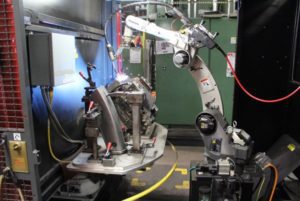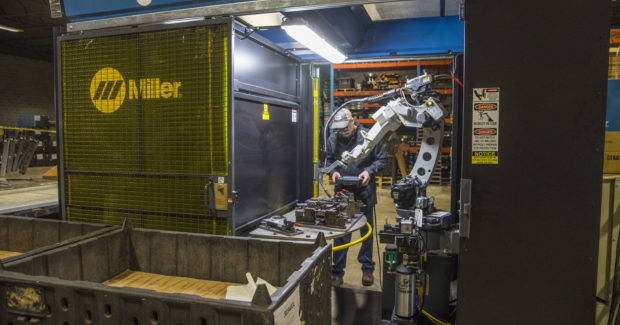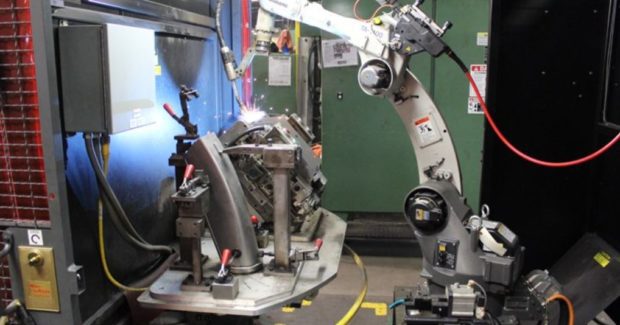Four Questions to Ask if You’re Considering Automated Welding
Your journey toward welding automation may not be a direct path. Your best option might be a multi-step, multi-purchase process.
Posted: July 18, 2022

WELDING TIPS
Welding automation can deliver numerous benefits for manufacturing operations, but how do you know if automating your welding process is the right fit?
It’s important to consider several factors, including the parts you’re producing and the overall goals of your operation. Choosing the right type of automation system is also key to achieving the results you want.
Learn more about the benefits of automation and four questions to ask before implementing welding automation in your operation.
Why Welding Automation?
If your operation struggles with issues such as rework and scrap costs, labor shortages, part quality or low productivity, automated welding could be a solution. Robotic welding can increase productivity and quality while minimizing scrap and rework costs and downtime.
With robotic welding, operations can eliminate part variation, reduce waste and rework, and increase productivity.
A general rule of thumb is that an optimized automated welding system can produce a three-to-one output improvement over a human operator. As a result, more operations are turning to automated welding as an answer to the skilled labor shortage.
Four questions to consider about welding automation:
- What type of parts does my operation produce? Welding automation is well suited to manufacturers that have high part volume with low part sophistication. In other words, simple and repeatable parts. Large, complex parts can be more difficult to weld robotically. A robot OEM or integrator can help you determine what options are best for your production needs, and they can help you optimize the system for the best results.
- How do my upstream processes look? An automated welding system is only as successful as the upstream processes that feed into it. Failing to consider upstream processes and whether they are optimized can hinder the results you get from your automation investment. When looking upstream, be sure that part preparation and fit-up are consistent and repeatable. While robots can adapt to some inconsistency in part fit-up or welds, this often requires more expensive options and complicates the process. Ensuring that repeatable parts are loaded into the fixturing helps ensure you’re producing quality parts.
- What is my labor situation? Investing in welding automation doesn’t mean you won’t need people in the welding operation. You will need trained operators to oversee the process and programming. Be sure operators have the necessary training to run the system properly. In addition, because robotic welding can reduce the bottleneck of the welding process, this may free up hand welders who can be used elsewhere. You can shift them to parts of the process that cannot be automated or to other areas that can’t keep up because of the high throughput of the robot.
- What are my goals? To determine if robotic welding is a good fit — and to help you choose the right system — you must know what results you want to achieve. Do you want to improve productivity? Reduce rework and scrap? Make it easier to train new welders? All of these outcomes are possible with an optimized robotic system. Understanding where you want to go will help you know where to start.
Automated Welding Options
If you decide automated welding is a good choice for your operation, there are several options to consider. Robotic welding solutions are not one size fits all, so be sure to think about which one is the best fit.
Some traditional automation systems, such as Miller® PerformArc™ robotic welding systems, are available as pre-engineered, ready-to-weld cells. With these systems, it can be quick and simple to add an automated welding cell. In addition to fast installation, these systems offer a lower total cost of ownership, lower risk, increased productivity, and operator and cell protection.
More advanced robotic welding systems, such as those that use two robots welding in tandem, are also available. However, these systems are often more complicated to program and operate, which increases the risk of the investment.
Cobots (short for collaborative robots) are another option. They are an emerging technology with many still-developing solutions. While they are still industrial robots, cobots feature intuitive user interfaces that can be less costly for operations to adopt as a first step toward automation — as well as less intimidating for operators to learn and use. These systems can especially be a good fit for manufacturers that produce simple parts. The main differences between cobots and traditional automated welding systems involve safety standards and expectations. Compared to cobots, traditional industrial robots will have much higher rates of speed and therefore more safety guards in place. This typically results in much greater productivity gains with traditional robots; they can do more complex parts and more part manipulation when required. The faster speeds can also help operations meet goals for productivity and throughput.
Consider Welding Automation
An operation’s journey toward implementing welding automation may not be a direct path. Your best option might be a multi-step, multi-purchase process. Keep in mind that there are many different robotic welding solutions to meet a range of needs. Choosing the right fit can deliver significant benefits and help you improve productivity and reduce costs.
Subscribe to learn the latest in manufacturing.

















